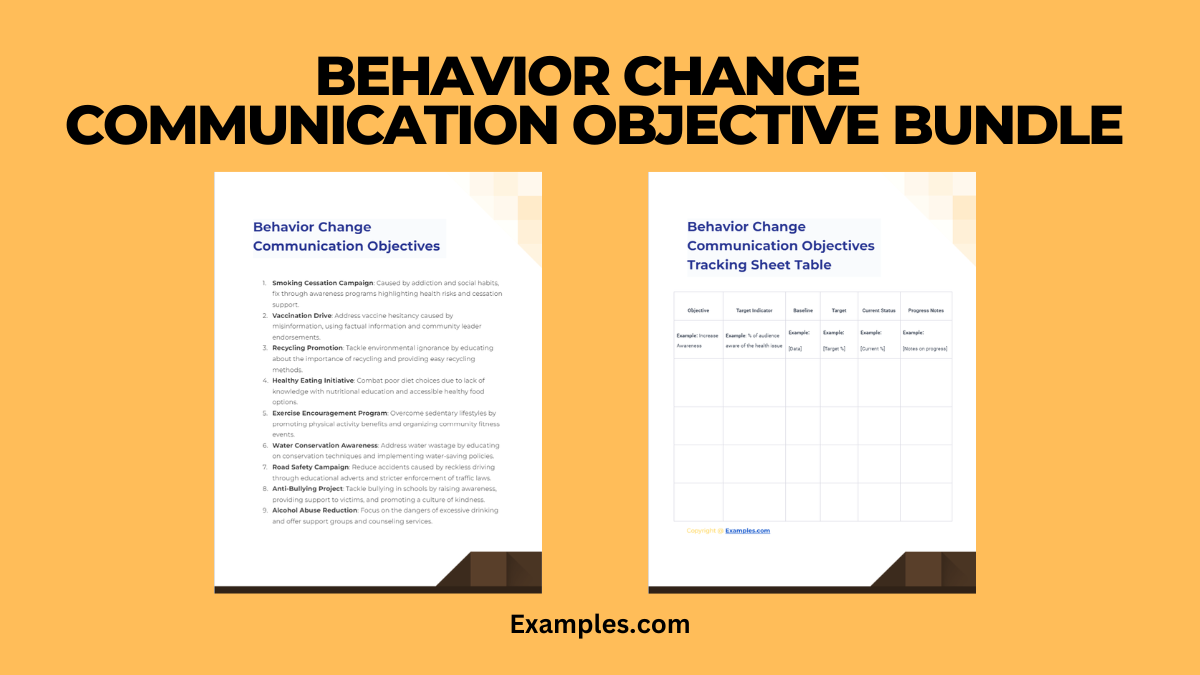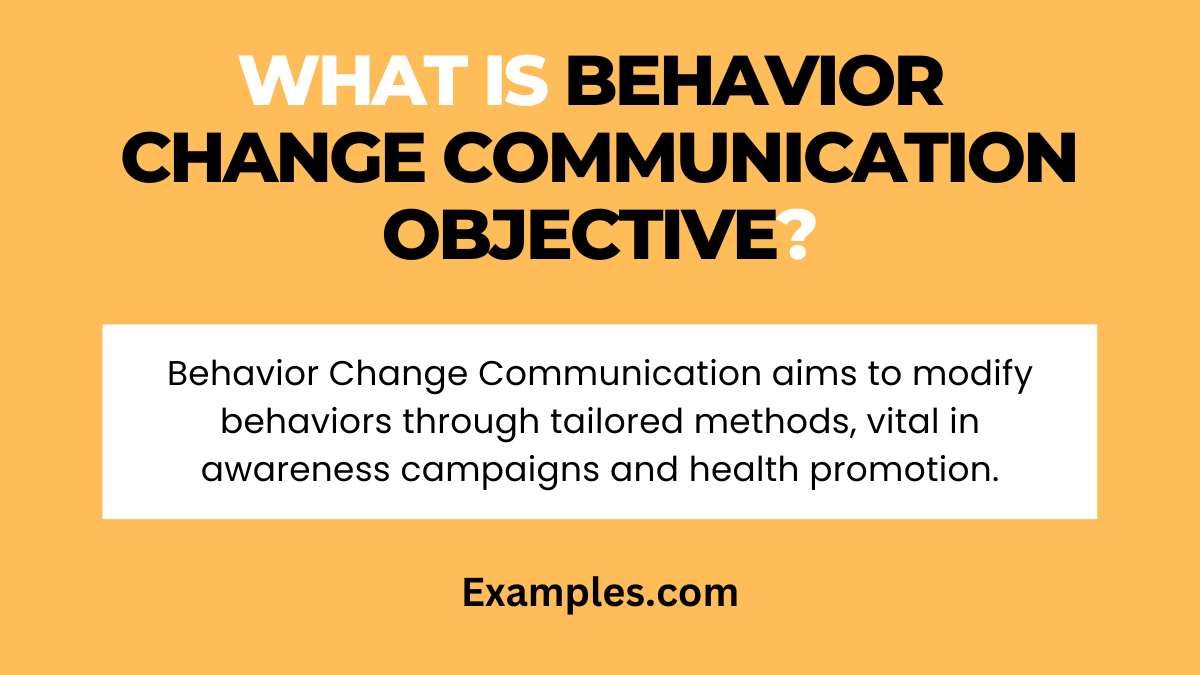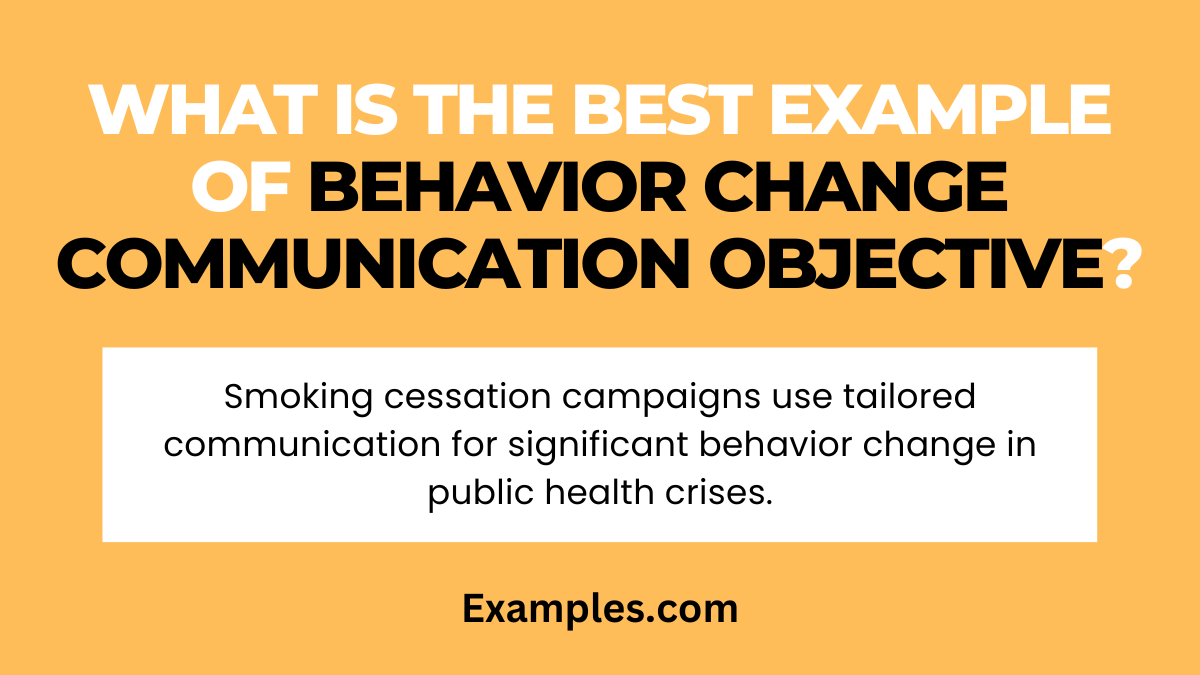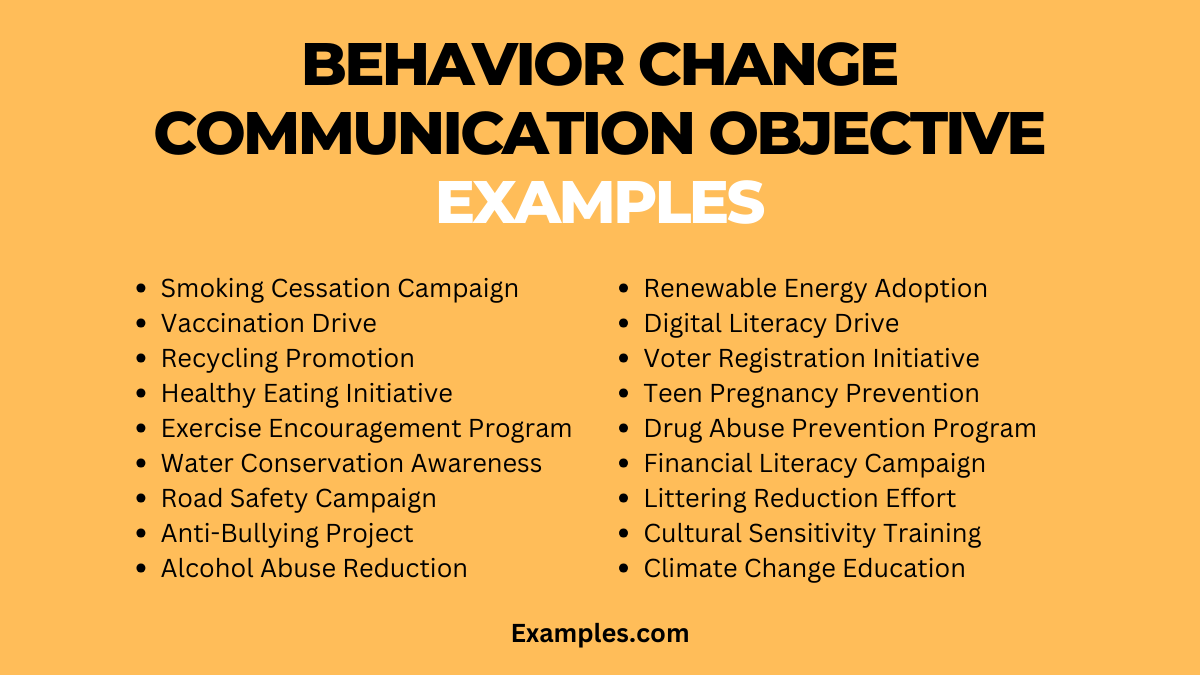99+ Behavior Change Communication Objective Examples
Dive into the dynamic world of Behavior Change Communication Objective with this complete guide. Featuring vivid Communication Examples, the guide illuminates the path to effective behavioral change. Whether it’s for public health or social development, understanding these objectives is crucial for crafting impactful messages and strategies. Explore how communication can shape behaviors and influence societal norms for positive change.

Download Behavior Change Communication Objectives Table PDF
Download Behavior Change Communication Objectives PDF
What is Behavior Change Communication Objective?

A Behavior Change Communication Objective is a strategically planned approach aiming to modify specific behaviors within a target audience. It’s a cornerstone in Public Awareness Campaigns and Health Promotion Techniques. Essentially, it involves identifying undesirable behaviors and using tailored communication methods to encourage positive change, be it in public health, environmental conservation, or community development. This method is often linked with Awareness Building Communication Objective and Relationship Building Communication Objective, focusing on fostering a deeper understanding and connection with the audience.
What is the Best Example of Behavior Change Communication Objective?

The Best example of a Behavior Change Communication Objective can be seen in campaigns addressing smoking cessation. These initiatives typically blend Social Marketing Strategies and Educational Outreach Programs to reach and persuade the target audience. By presenting compelling information about the risks of smoking and offering support for quitting, these campaigns exemplify how well-crafted communication can lead to significant behavioral changes. They also often incorporate Behavioral Intervention Methods and Communication Strategy Planning, demonstrating the multi-faceted approach needed for effective behavior change. Such campaigns align closely with Reputation Management Communication Objective and Crisis Communication Objective, addressing a public health crisis and building a positive public perception around health initiatives.
20 Behavior Change Communication Objective Examples

Discover the transformative power of Behavior Change Communication Objectives through 20 unique and impactful examples. Each example illustrates the causes behind specific behavior patterns and offers targeted strategies for effective change. From public health initiatives to environmental advocacy, these examples provide a deep understanding of how strategic communication can reshape behaviors and influence societal norms. They embody principles of Employee Motivation Communication Objective and Market Positioning Communication Objective, aiming to motivate individual behavior change and position health and environmental issues prominently in public discourse.
- Smoking Cessation Campaign: Caused by addiction and social habits, fix through awareness programs highlighting health risks and cessation support.
- Vaccination Drive: Address vaccine hesitancy caused by misinformation, using factual information and community leader endorsements.
- Recycling Promotion: Tackle environmental ignorance by educating about the importance of recycling and providing easy recycling methods.
- Healthy Eating Initiative: Combat poor diet choices due to lack of knowledge with nutritional education and accessible healthy food options.
- Exercise Encouragement Program: Overcome sedentary lifestyles by promoting physical activity benefits and organizing community fitness events.
- Water Conservation Awareness: Address water wastage by educating on conservation techniques and implementing water-saving policies.
- Road Safety Campaign: Reduce accidents caused by reckless driving through educational adverts and stricter enforcement of traffic laws.
- Anti-Bullying Project: Tackle bullying in schools by raising awareness, providing support to victims, and promoting a culture of kindness.
- Alcohol Abuse Reduction: Focus on the dangers of excessive drinking and offer support groups and counseling services.
- Mental Health Awareness: Break the stigma around mental health issues with open discussions and accessible mental health services.
- Renewable Energy Adoption: Promote the shift from fossil fuels by highlighting benefits and subsidies for renewable energy sources.
- Digital Literacy Drive: Address the digital divide by offering technology education and resources in underserved communities.
- Voter Registration Initiative: Encourage democratic participation by simplifying the registration process and educating on its importance.
- Teen Pregnancy Prevention: Educate teens on sexual health and provide access to contraceptives and counseling.
- Drug Abuse Prevention Program: Tackle drug addiction through early education, support systems, and rehabilitation services.
- Financial Literacy Campaign: Improve financial management skills by offering educational workshops and budgeting tools.
- Littering Reduction Effort: Combat littering through public awareness campaigns and implementing stricter penalties.
- Cultural Sensitivity Training: Promote inclusivity and respect for diversity in workplaces through targeted training sessions.
- Climate Change Education: Highlight the impacts of climate change and advocate for sustainable practices.
- Wildlife Conservation Project: Address threats to wildlife by promoting habitat protection and anti-poaching laws.
Social Behavior Change Communication Objective Examples
Social Behavior Change Communication (SBCC) objectives play a crucial role in transforming community dynamics and improving societal well-being. These objectives focus on altering social behaviors through targeted communication strategies, thereby creating a positive impact on communities. Here are five unique examples, each reflecting a Sales Enhancement Communication Objective or a Stakeholder Trust Building Communication Objective. These examples demonstrate how SBCC can enhance community engagement and build trust among stakeholders through clear, persuasive communication focused on societal benefits. Here are five unique examples:
- Promoting Gender Equality: Address gender stereotypes by encouraging discussions on equality.
Communicate: “Let’s talk about equality and respect for all genders.” - Anti-Plastic Campaign: Combat plastic pollution by advocating for sustainable alternatives.
Communicate: “Join us in choosing eco-friendly alternatives to plastic.” - Cyberbullying Prevention: Raise awareness about the impact of cyberbullying and promote online kindness.
Communicate: “Spread kindness, not hate, in our digital world.” - Community Health Drives: Tackle local health issues by educating communities on prevention and care.
Communicate: “Your health is our community’s wealth. Let’s learn how to protect it.” - Promoting Civic Participation: Encourage active citizenship and participation in local governance.
Communicate: “Your voice matters. Get involved in our community’s decisions.”
Goals of Behavior Change Communication Objective
The goals of Behavior Change Communication Objectives are centered on altering behaviors and attitudes for improved social and health outcomes.
- Influence Behavioral Patterns: The primary goal is to positively alter existing behaviors, such as improving health habits or increasing civic participation, utilizing Public Awareness Campaigns and Behavioral Intervention Methods.
- Educate and Inform: To disseminate knowledge and information effectively, often through Educational Outreach Programs and Information Dissemination Communication Objectives.
- Promote Social Well-being: Aiming at enhancing the overall social health and cohesion of a community, supported by Social Marketing Strategies and Community Engagement Approaches.
- Encourage Healthy Practices: Focus on encouraging healthier lifestyle choices through Health Promotion Techniques and Awareness Building Communication Objectives.
- Drive Policy Change: Advocate for policy adjustments that support the targeted behavior change, integrating Advocacy in Public Health and Persuasion Communication Objectives.
- Foster Community Participation: Encouraging active involvement and feedback from the target audience, facilitated by Audience Engagement Communication Objective and community forums.
- Ensure Cultural Relevance: Ensuring messages are culturally appropriate and respectful, using Cultural Sensitivity in Communication and localized content.
Importance of Behavior Change Communication Objective
Understanding the importance of Behavior Change Communication is essential in creating impactful strategies that effectively influence social and individual behavior.
- Improves Public Health Outcomes: Significantly impacts public health by promoting healthier behaviors, leveraging Health Promotion Techniques and Public Awareness Campaigns.
- Supports Social Change: Facilitates social change by addressing societal issues like gender equality or environmental conservation through Social Marketing Strategies.
- Enhances Knowledge Dissemination: Plays a crucial role in spreading vital information, employing methods like Educational Outreach Programs and Information Dissemination Communication Objectives.
- Promotes Inclusive Participation: Encourages diverse community participation, utilizing Community Engagement Approaches and Audience Engagement Communication Objectives.
- Supports Sustainable Practices: Advocates for sustainability in various fields, particularly environmental conservation, using Behavioral Intervention Methods and Advocacy in Public Health.
- Boosts Cultural Understanding: Helps in bridging cultural gaps and promoting mutual respect, achieved through Cultural Sensitivity in Communication.
- Shapes Policy and Governance: Influences policy-making and governance, aligning with Persuasion Communication Objectives and public advocacy campaigns.
Steps of Behavior Change Communication Objective
The steps for achieving Behavior Change Communication Objectives include audience analysis, message development, and strategic implementation of communication tactics.
- Identify the Target Behavior: Pinpoint the specific behavior that needs to be changed, using Behavioral Intervention Methods and Health Promotion Techniques.
- Understand the Audience: Deeply analyze the target audience’s needs, beliefs, and attitudes, incorporating Cultural Sensitivity in Communication.
- Develop Strategic Messages: Craft compelling and relevant messages, guided by Communication Strategy Planning and Educational Communication Objectives.
- Choose the Right Channels: Select appropriate communication channels that resonate with the audience, utilizing Social Marketing Strategies.
- Implement the Strategy: Execute the communication plan effectively, supported by Public Awareness Campaigns and Community Engagement Approaches.
- Monitor and Evaluate: Regularly assess the impact and effectiveness of the communication, through Program Monitoring and Evaluation.
- Adapt and Evolve: Continuously refine and adapt the strategy based on feedback and results, employing Feedback Generation Communication Objectives.
Principles of Behavior Change Communication Objective
The principles of Behavior Change Communication emphasize audience understanding, message clarity, and cultural sensitivity for effective communication.
- Audience Understanding: Grasp the needs, beliefs, and attitudes of the target audience. This requires Communication Strategy Planning to ensure messages resonate.
- Message Clarity: Ensure clear, concise, and compelling messaging. Educational Outreach Programs often hinge on this principle for effectiveness.
- Cultural Relevance: Tailor messages to fit cultural norms, employing Cultural Sensitivity in Communication.
- Multichannel Approach: Use a variety of channels, from traditional media to digital platforms, for comprehensive Public Awareness Campaigns.
- Feedback Integration: Adapt strategies based on audience feedback, a key aspect of Behavioral Intervention Methods.
- Partnership and Collaboration: Engage with stakeholders and communities through Community Engagement Approaches.
- Sustainability and Evaluation: Regular Program Monitoring and Evaluation ensures long-term success and adaptability.
How to Develop Behavior Change Communication Objective
Developing Behavior Change Communication Objectives involves understanding the target audience and crafting strategic messages to influence behavior.
- Identify the Issue: Clearly define the behavioral issue you want to address, considering Public Health Advocacy when relevant.
- Audience Research: Understand your target audience’s characteristics, using insights for Communication Strategy Planning.
- Set Clear Objectives: Define specific, measurable goals, aligned with Health Promotion Techniques.
- Develop the Message: Create impactful messages, using Educational Communication Objectives as a guide.
- Choose the Right Channels: Select appropriate media platforms for Information Dissemination Communication Objective.
- Implement the Strategy: Roll out the campaign, integrating Social Marketing Strategies.
- Evaluate and Adapt: Continuously monitor and refine the approach, a critical part of Behavior Change Communication Objective.
For instance, in public health, BCC plays a critical role in educating communities about healthy practices and preventing diseases. A comprehensive guide on this can be found on UNESCO’s resource page (Behavior Change Communication (BCC) for HIV/AIDS: A Strategic Framework). This resource elaborates on how BCC strategies are employed in HIV/AIDS prevention and control, providing a clear framework for similar health-related initiatives.
BCC is not limited to health; it’s also crucial in environmental initiatives. An excellent example is water resource management, where behavior change is necessary for sustainable practices. The IWRM Action Hub provides insights into this through their page on behavior communication change, which can be accessed here: Behavior Communication Change in IWRM. This resource highlights the importance of BCC in promoting sustainable water management practices.



